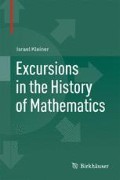Abstract
Fermat, though a lawyer by profession and only an “amateur” mathematician, is regarded as the founder of modern number theory. What were some of his major results in that field? What inspired his labors? Why did he not publish his proofs? How did scholars attempt to reconstruct them? Did Fermat have a proof of Fermat’s Last Theorem? What were the attitudes of seventeenth-century mathematicians to his number theory? These are among the questions we will address in this chapter.
Access this chapter
Tax calculation will be finalised at checkout
Purchases are for personal use only
References
W. W. Adams and L. J. Goldstein, Introduction to Number Theory, Prentice-Hall, 1976.
A. G. Agargün and E. M. Özkan, A historical survey of the Fundamental Theorem of Arithmetic, Hist. Math. 28 (2001) 207-214.
E. Bach and J. Shallit, Algorithmic Number Theory, Vol. 1, MIT Press, 1996.
A. Baker, Transcendental Number Theory, Cambridge Univ. Press, 1990.
K. Barner, How old did Fermat become?, NTM, Intern. Jour. Hist. and Ethics of Natur. Sc., Techn. and Med. 8 (4) (October 2001).
E. J. Barbeau, Pell’s Equation, Springer, 2003.
I. G. Bashmakova, Diophantus and Diophantine Equations, Math. Assoc. of Amer., 1997. (Translated from the Russian by A. Shenitzer.)
E. T. Bell, Men of Mathematics, Simon and Schuster, 1937.
F. Bornemann, PRIMES is in P: A breakthrough for ‘everyman’, Notices of the Amer. Math. Soc. 50 (2003) 545-552.
D. M. Bressoud, Factorization and Primality Testing, Springer, 1989.
D. A. Cox, Primes of the Formx 2 + ny 2: Fermat, Class Field Theory, and Complex Multiplication, Wiley, 1989.
L. E. Dickson, History of the Theory of Numbers, 3 vols., Chelsea, 1966.
H. M. Edwards, Fermat’s Last Theorem: A Genetic Introduction to Algebraic Number Theory, Springer, 1977.
C. R. Fletcher, A reconstruction of the Frenicle-Fermat correspondence, Hist. Math. 18 (1991) 344–351.
C. R. Fletcher, Fermat’s theorem, Hist. Math. 16 (1989) 149–153.
K. Fogarty and C. O’Sullivan, Arithmetic progressions with three parts in prescribed ratio and a challenge of Fermat, Math. Mag. 77 (2004) 283–292.
J. R. Goldman, The Queen of Mathematics: A Historically Motivated Guide to Number Theory, A K Peters, 1998.
E. Grosswald, Representation of Integers as Sums of Squares, Springer, 1985.
G. H. Hardy and E. M. Wright, An Introduction to the Theory of Numbers, 4th ed., Oxford Univ. Press, 1959.
T. L. Heath, Diophantus of Alexandria: A Study in the History of Greek Algebra, 2nd ed., Dover, 1964. (Contains a translation into English of Diophantus’ Arithmetica, a 130-page Introduction to Diophantus’ and related work, and a 60-page Supplement on Fermat’s number-theoretic work.)
T. L. Heath (ed.), The Thirteen Books of Euclid’s Elements, 3 vols., 2nd ed., Dover, 1956.
K. Iga, A dynamical systems proof of Fermat’s little theorem, Math. Mag. 76 (2003) 48-51.
K. Ireland and M. Rosen, A Classical Introduction to Modern Number Theory, Springer, 1982.
I. Kleiner, A History of Abstract Algebra, Birkhäuser, 2007.
D. Mackenzie and B. Cipra, What’s Happening in the Mathematical Sciences, Amer. Math. Soc., 2006.
M. S. Mahoney, The Mathematical Career of Pierre de Fermat, 2nd ed., Princeton Univ. Press, 1994.
B. Mazur, Mathematical perspectives, Bull. Amer. Math. Soc. 43 (2006) 309–401.
B. Mazur, Questions about powers of numbers, Notices Amer. Math. Soc. 47 (2000) 195–202.
L. J. Mordell, Diophantine Equations, Academic Press, 1969.
C. J. Mozzochi, The Fermat Diary, Amer. Math. Soc., 2000.
H. Riesel, Prime Numbers and Computer Methods for Factorization, 2nd ed., Birkhäuser, 1994.
W. Scharlau and H. Opolka, From Fermat to Minkowski: Lectures on the Theory of Numbers and its Historical Development, Springer, 1985.
J. Stillwell, Elements of Number Theory, Springer, 2003.
J. Stillwell, Mathematics and its History, 2nd ed., Springer, 2002.
P. Tannery and Ch. Henry (eds.), Oeuvres de Fermat, 4 vols., Gauthier-Villars, 1891-1912, and a Supplément, ed. by C. de Waard, 1922.
C. Vaughan and T. D. Wooley, Waring’s problem: a survey. In Number Theory for the Millennium III, ed. by M. A. Bennett et al, A K Peters, 2002, pp. 301-340.
A. Weil, Number Theory: An Approach through History, from Hammurapi to Legendre, Birkhäuser, 1984.
H. C. Williams, Solving the Pell equation. In Number Theory for the Millennium III, ed. by M. A. Bennett et al, A K Peters, 2002, pp. 397-435.
B. H. Yandell, The Honors Class: Hilbert’s Problems and their Solvers, A K Peters, 2002.
Author information
Authors and Affiliations
Corresponding author
Rights and permissions
Copyright information
© 2012 Springer Science+Business Media, LLC
About this chapter
Cite this chapter
Kleiner, I. (2012). Fermat: The Founder of Modern Number Theory. In: Excursions in the History of Mathematics. Birkhäuser Boston. https://doi.org/10.1007/978-0-8176-8268-2_2
Download citation
DOI: https://doi.org/10.1007/978-0-8176-8268-2_2
Published:
Publisher Name: Birkhäuser Boston
Print ISBN: 978-0-8176-8267-5
Online ISBN: 978-0-8176-8268-2
eBook Packages: Mathematics and StatisticsMathematics and Statistics (R0)

